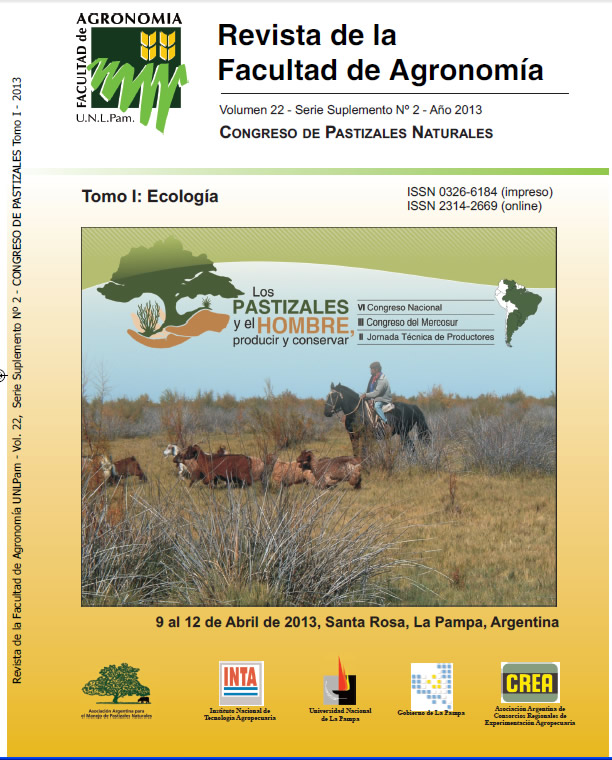Determination of relationship between data obtained from biomass derived from field and remote sensing ndvi along the arroyo Chucul (Pcia. Córdoba)
Keywords:
NDVI, Green biomasa, Grassland, CorrelationAbstract
The values of green biomass (Bv) measured in a grassland were associated with index values of normalized difference vegetation index (NDVI) from satellite data in three relict natural grassland on stream Chucul, from his beginning site 1 (32° 49'21, 0” S and 64° 24`07.0”W) until its demise in plain area: site 3 (33° 06` 25.5`` S and 63° 32`49.1`` W). Under the hypothesis of correspondence of Bv and data obtained by images, the aim of this work is to determine the relationship between measured field data and satellite data in natural grasslands. Seasonally during the 2009-2011 cycle were sampled at random with 10 replicates of 0.25 m2 recording floristic list. To determine Bv in each plot the biomass was cut and separated in green and dry compartments and dryed to constant weight. For digital analysis bands 3 and 4 of Landsat 5 TM image (Path 228 Row 083) were used for
each site close to the sampling date. The highest values of green biomass were determined for site 3, in December 2011: 189.6 g/m2 and in March for sites 1 and 2: 105.74 and 115.22 g/m2. Among all the observed values of biomass and NDVI estimated the correlation coefficient was highest at site 3 (R= 0.50). The results of the work for site 3 validate the hypothesis and indicats of the aptitude of digital images for study the status and changes in vegetation.
Downloads
References
Asrar G., M. Fuchus, E.T. Kanemasu & J.L. hatfield. 1984. Estimation absorbed photosynthetic radiation and leaf area index from spectral reflectance in wheat. Agron. J. 76: 300-306.
Baret F. & G. Guyot. 1989. Potentials and limits of vegetation indices for LAI and APAR assessment. Remote Sens. Environ. 35: 161-173.
Boyd W. 1986. Correlation of rangelands brush canopy cover with Landsat MSS data. J. Range Manage. 39: 268- 271.
Chen J. 1995. Integrating AVHRR derived NDVI with Ecological Modelling. Middle States Goegrapher. Vol. 28.
Chuvieco E. 1996. Fundamentos de Teledetección Espacial. Eds RIALP.S.A. Madrid, España.
Curran P.J. 1983. Multispectral remote sensing for the estimation of green leaf area index. Philosophical Transactions of the Royal Society of London A. 309: 257-270.
Gerberman A.J., J.A. Cuellar & H.W. Gausman, 1984. Relationship of sorghum canopy variables to reflected infrared radiation for 2 wavelengths and 2 wavebands. Photogramm. Eng. Rem.S. 50: 209-214.
Mársico L. & A. Altesor. 2011. Relación entre la riqueza de especies vegetales y la productividad en pastizales naturales. Ecol. Austral 21: 101-109.
Paruelo J.M., H.E. Epstein, W.K Lauenroth & I.C. Burke. 1997. A NPP estimates from NDVI for the Central Grassland Region of the US. Ecology 78: 953-958.
Prince S.D. 1991. A model of regional primary production for use with coarse resolution satellite data. Int. J.Remote S. 12: 1313-1330.
Pucheta E., E. Ferrero, L. Heil & C. Schneide. 2004. Modelos de regresión para la estimación de la biomasa aérea en un pastizal de montaña de Pampa de Achala (Córdoba, Argentina). Agriscientia 21(1): 23-30.
Pueyo J.M., L. Lacopini, Y. Bonini, J. Fonseca, R. Ludi & R. Grancell. 2003. Productividad del campo natural. Publicaciones. EEA INTA Paraná, Entre Ríos.
Pueyo J.M., L. Lacopini, Y. Bonini, J. Fonseca R. Ludi & R. Grancell. 2005. Productividad del Pastizal Natural. EEA Concepción del Uruguay.
Sánchez Rodríguez E, M.á. Torres Crespo, A. Fernández Palacios Carmona, M. Aguilar Alba, I. Pino Serrato & L. Granado Ruiz. 2000. Comparación del NDVI con el PVI y el SAVI como Indicadores para la Asignación de Modelos de Combustible para la Estimación del Riesgo de Incendios en Andalucía. Tecnologías Geográficas para el Desarrollo Sostenible. Departamento de Geografía. Universidad de Alcalá. pp. 164-174.
Sellers P.J. 1985. Canopy reflectance, photosynthesis, and transpiration. Int. J. Remote S. 6: 1335-1372.
Rueter B. & M. Bertolani 2005. Evaluación de la Productividad, Degradación y Ritmos Bioclimáticos en Ecosistemas áridos del Distrito Central, Mediante la Utilización de Percepción Remota. Nat. Patagón.1: 66-72.
Tucker C.J. 1977. Resolution of grass canopy biomass classes. Photogramm. Eng. Rem. S. 43: 1059-1067.
Downloads
Published
Issue
Section
License
La Editorial de la Universidad Nacional de La Pampa (EdUNLPam) exigirá a los/as autores/as la firma del siguiente documento:
La EdUNLPam lleva a cabo la publicación del artículo: (Título del Artículo) en SEMIÁRIDA Rev.Fac.Agron UNLPam ISSN 2362-4337 (impresa) ISSN 2408-4077 (en línea), del cual el/los abajo firmantes son autores de una o más partes. En el mismo acto, el/los autores entregan exclusivamente a la EdUNLPam todos sus derechos protegidos por las leyes de propiedad intelectual que rigen en la Argentina para reproducir, publicar, editar, fijar, comunicar y transmitir públicamente en cualquier formato o medio impreso o electrónico, inclusive internet, el artículo enviado a publicación e incluirlo en índices o bases de datos nacionales e internacionales. A cambio, la EdUNLPam entrega a los autores la autorización para la publicación o reimpresión con ines académicos y educativos en cualquier libro o medio de divulgación, con la sola obligación de citar el artículo original publicado en la EdUNLPam. Cada autor acuerda en que el material provisto a la EdUNLPam es un trabajo original, que no ha sido impreso o publicado en cualquier otro medio con anterioridad y que no vulnera derechos de terceros. El Primer autor tendrá la posibilidad de leer y corregir el artículo ya editado como “prueba de galera”, pero si el autor no devolviera esas correcciones de la prueba de galera dentro del tiempo especificado, el proceso de producción y publicación podrá proseguir sin la aprobación del autor. El/los autor/es no recibirán compensación monetaria de la EdUNLPam por el uso del material contenido en este artículo y asumen la responsabilidad de las opiniones vertidas en él.






.png)



22.png)



.jpg)




.jpg)
